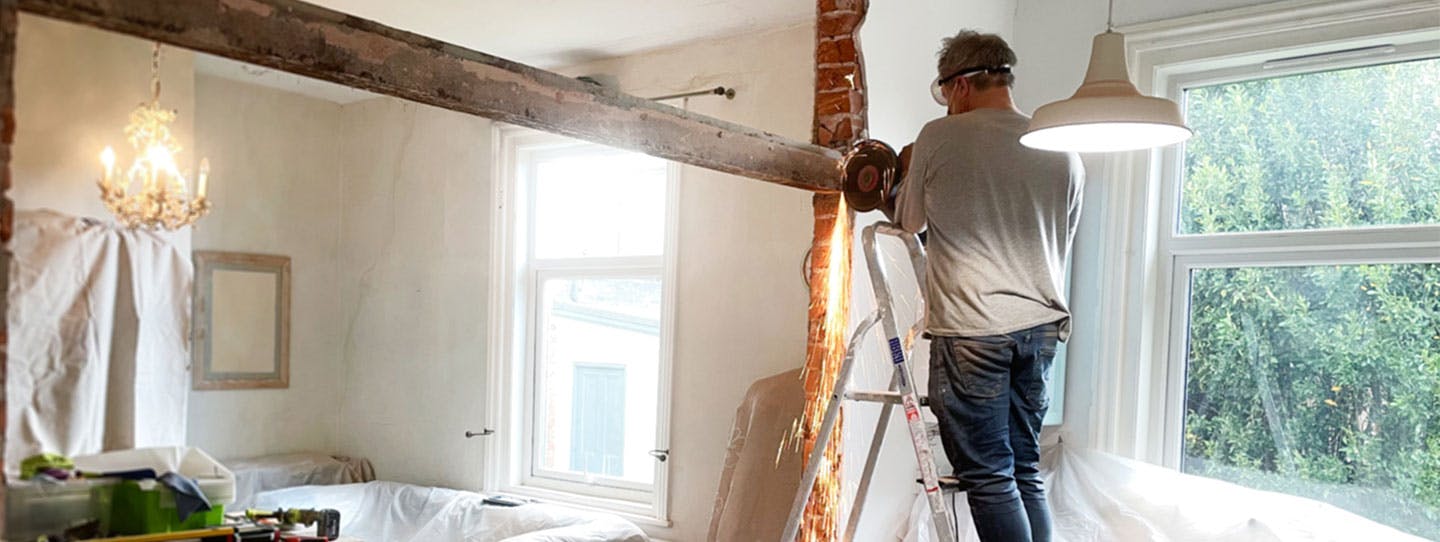
The BRRRR method seems, at first glance, to be a loud declaration of chilliness. But no, it’s not about being cold or needing an extra sweater.
BRRRR stands for Buy, Rehab, Rent, Refinance, Repeat. It’s a type of real estate investment that helps you grow your investment and purchasing power over time, through a cycle of buying, improving, and renting out property to generate passive income.
This article will show you the BRRRR method in action, walk through each step in the cycle, and reveal ways to make the process easier if you’re new to this style of investment. Let’s jump in.
The BRRRR Cycle, Explained
An example: Sally buys a property in Dallas that’s in need of a little TLC. She purchases the home for $150,000 with a 20% downpayment of $30,000, then gets a loan for the additional $120,000.
Next, she applies $40,000 of renovations to the property, hoping that these upgrades will double the value of the original purchase.
After renovations are complete, Sally has her property re-appraised at $300,000 (Well done, Sally!) and is able to rent it out for $2,500 a month. After a couple of years of collecting passive income on the property, Sally is ready to repeat the process.
She takes out another loan for $200,000 (a fraction of the value of her current property), uses it to pay off the original loan of $120,000, and begins the process again with a start-up fund of $80,000 PLUS her ongoing passive rental income.
Of course, Sally’s experience is the simplest version available. The actual application of the BRRRR method requires a bit more elbow grease.
Buy
First, you’ll want to assess the market fully. You’ll need to invest time in researching so you thoroughly understand the local market. Identifying potential properties takes time and attention. This step cannot be rushed.
Remember, you’re not only looking for a property that’s affordable, but also assessing the possible ARV (after repair value) of the project. What is the average rental price in the neighborhood? In the city? In the county? How can you compete with this price while taking on the debt necessary to renovate the property thoroughly?
During the “buy” step, you’ll be assessing the entire process, not just the purchasing of the property. What rehab will be necessary? Will it price you out of the local market? What zoning laws apply that may restrict development? It cannot be stressed enough that a successful BRRRR real estate investor must understand local market politics and trends.
Rehab
Once you’ve found and purchased the perfect property, it’s time for rehab. Of course, there are nearly countless ways to renovate a property, but the BRRRR method is about quick turnaround and successful rentals. As a rule, you’ll want to ensure that you always invest in four key areas: roof, bedrooms, bathrooms, and landscaping.
Roof
In most districts, you can’t legally rent a property without a properly functioning roof. Leaks aren’t acceptable and can be grounds for a tenant breaking their lease without warning—a landlord’s nightmare. Make sure you’ve invested in a roof that does its job.
Bedrooms
Adding a bedroom is a guaranteed boost in property value and property rentability. Especially with so many people working from home nowadays, an additional bedroom (even a small one) can make a great office space. Plus, this type of renovation can be extremely affordable. Some drywall and a door and you’re good to go!
Bathrooms
One of the first things tenants notice is the state of the bathrooms. If your property has dingy, outdated bathrooms, this is an essential area to invest in. Install new tile, toilets, sinks, and bathtubs for an immediate upgrade in value and rental appeal.
Landscaping
First impressions are critical. What do people see when they arrive at the property for the first time? Curb appeal may seem silly and shallow, but investing in landscaping for the front yard will always be money well spent.
Rent
Once your rehab is complete, it’s time to start that passive income train! Make sure you’re renting your property for a price that’s fair for both the tenant and you, the investor.
Finding the best tenant for your property can be tricky. You’ll also want to screen tenants properly to ensure you enter into contracts with people you can trust to pay rent on time and take care of the property you’ve invested so much in. It’s best to have a few months’ expenses in reserve so you can take your time finding the right tenant instead of filling the property as soon as possible.
In the best-case scenario, you’re looking for long-term, reliable tenants who you’ll be happy to serve and partner with for years. Make sure you review these essential questions to ask tenants before signing anything!
Refinance
Hooray—your property is rented out and you’re collecting that regular passive income. Congratulations!
Depending on your timeline, this may be a good place to take a breather, pause for a moment and enjoy the fruits of your labor. You’ve worked extremely hard getting to a point where you can sit back and collect passive income.
But, whenever you’re ready to move forward with gusto, there are several things to consider during the refinance phase. In fact, you may already have begun this phase alongside other parts of the process. It can be beneficial to consider refinancing before you buy, bringing lenders in on your plans, and even getting prequalified for your refinance loans.
If you’re looking to shorten your timeline between projects, you should begin to collect necessary documents during the rehab phase. Some forms you may need include:
- W2s
- LLC documentation
- Pay stubs
- And tax information
Staying in communication with your lender during this phase is essential to keep the project moving forward.
Since you already own a property, you may consider a HELOC (home equity line of credit) which saves you time in repeating the process since you don’t need an additional appraisal to move forward. Another option to discuss with your lender is a cash-out refinance. This is typically available to investors with a credit score of 620 or higher.
But, traditionally, the refinance phase is when you’ll schedule an appraisal on your newly rehabbed property so that your assets are properly evaluated and you’re eligible for larger loans. You’ll need to schedule your appraisal, prep and clean the space so it shows well, and be present for the appraisal if possible.
Also, consider creating an appraisal packet to show the work you’ve done on the space. Bonus points for including before and after photos, the budget you worked with, and documentation regarding rehab.
Repeat
And now it’s time to rinse and repeat! Before jumping back into the buying phase, take a moment to assess the steps you’ve taken so far. Make note of what worked well and where the process was stressful or trying. What tweaks can you make to ensure the next cycle is easier and quicker?
Since the market is always evolving, you may not be looking at the same landscape as the last time you bought property. Refresh your knowledge of the local market. What’s changed? What neighborhoods are up and coming?
Then you’re ready to go again!
Is BRRRR for you?
While BRRRR is a method that is tried and true, it’s not a viable path for all real estate investors. You need a substantial amount of cash to get started and a high enough credit score for banks to trust you with substantial loans. The BRRRR Method Calculator is a helpful tool to see if it’s right for you.
While the pros of BRRRR are obvious—you’re able to generate long-term passive income, build a real estate rental portfolio, and it requires less cash upfront than other investing methods—make sure you’re not wearing rose-colored glasses and forgetting to consider the drawbacks. The cost and effort of rehabbing a home that you won’t get to live in and enjoy are high, and many investors don’t have the stamina or know-how to complete this step successfully. Plus, there’s always uncertainty about the future appraisal of your property. Nothing is guaranteed. You’ll be a landlord, which requires you to cultivate and maintain strong tenant rental relationships.
So, is this challenge for you?
When Things Get Tough
It’s both realistic and good business to look ahead toward what might overwhelm you down the line. Tenant turnover and retention can be difficult, and, without steady tenants, your passive income (and loan repayment schedule) can take a massive hit. Plus there are repairs and property upkeep that never stop. It’s easy to get overwhelmed, even at the best of times.
Many investors opt to hire a property management company to help with the day-to-day tasks of managing multiple properties. This is advantageous for several reasons:
- Hiring a local property management company brings in additional expertise of the local real estate market so you understand risks and rewards.
- This expertise helps you act quickly and confidently when the right opportunities do arise.
- Plus, a property management company will get the right renters into your property quickly and efficiently.
- Property managers have strong relationships with local vendors, repair companies, and other service providers, meaning you’ll often get reliable, higher-quality work for a better value.
- Working with a property management company is like having an expert partner who knows your vision, risk tolerance, and overall strategy.
Whether you decide to embark upon the BRRRR method as a solo act or in partnership with the experts at a property management company, the right preparation can yield high returns on your real estate investments long-term. If you’re up to the challenge, then the BRRRR method might be right for you.
